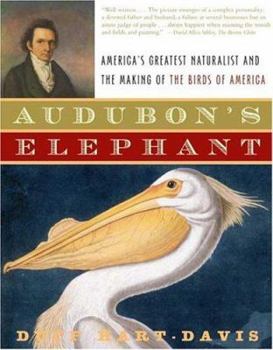Audubon's Elephant: America's Greatest Naturalist and the Making of the Birds of America
Select Format
Select Condition 
Book Overview
Illegitimate, half-French, half-American, poorly educated, chronically short of money and obsessed with birds, Audubon came to England in 1826 to find a publisher for his extraordinary paintings. He... This description may be from another edition of this product.
Format:Paperback
Language:English
ISBN:0805077758
ISBN13:9780805077759
Release Date:April 2005
Publisher:Henry Holt & Company
Length:288 Pages
Weight:1.25 lbs.
Dimensions:0.8" x 6.2" x 8.2"
Customer Reviews
1 rating
An American Classic From England
Published by Thriftbooks.com User , 20 years ago
Let us say the Book Fairy comes and says you can be given one book, any book you want. Here's my advice: take John James Audubon's _The Birds of America_. Of course you want the original edition, the volumes that appeared between 1826 and 1838. Not only is it one of the most beautiful books ever printed, if you get tired of it, you can sell it. The last one that came up for sale, in 2000, went for $8.8 million. Just about everyone knows about this book, or has seen reprints from it, and has heard of Audubon (perhaps because of the Society that bears his name) and associates him with birds. He has had several biographies, but _Audubon's Elephant: America's Greatest Naturalist and the Making of the Birds of America_ (Henry Holt) by Duff Hart-Davis takes a specific look at the extraordinary book, and how _The Birds of America_ could not have been made in America.Audubon's own adopted country had no room for his huge project of a book to show all the birds of America life sized. Naturalists at the time actively discouraged anyone's support of Audubon's efforts, and there were not printers up to the task. So in 1826, Audubon sailed with his big watercolors to England. He became a celebrated American rustic, captivating the town of Edinburgh. He went about carrying his huge portfolio which weighed nearly a hundred pounds, slung over his shoulder. The first printer of the work, having see it, responded, "My God! I never saw anything like this before." He was right; Audubon's pictures had size, drama, and color no previous bird pictures even hinted at. The pictures caused a sensation, and Audubon was caught in a whirl of dining and socializing that he enjoyed enormously. The enormous work of getting subscribers, printing the pictures, and getting a team of colorists to hand tint each one was more than Audubon had counted on. He wrote, "I am thrown into a vortex of business that I never conceived I could manage."Audubon and conservation have become synonymous, but his process of making his art will appall those many who belong to the Society bearing his name. Audubon probably killed more birds than any man in history, saying, "I call birds few when I shoot less than one hundred per day." He liked painting birds in action, but he posed them that way, killing them and mounting them so he could get the action stilled. A companion complained about Audubon working on his turkey painting, "The damned fellow kept it pinned up there till it rotted and stunk. I hated to lose so much good eating." Audubon kept a golden eagle in a cage to observe it, and having it seen alive sufficiently, tried to suffocate it with charcoal smoke, and when that did not work, pierced it through the heart with a pointed steel needle. As Hart-Davis realizes, Audubon did not lust for blood, but for knowledge. Imparting that knowledge through his art was his great goal, magnificently realized. _Audubon's Elephant_ is a much smaller volume than the original it desc





